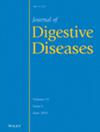Development and Validation of a Clinical Nomogram for Predicting Surgery in Newly Diagnosed Crohn's Disease
Abstract
Objectives
To develop a nomogram with easily available parameters to predict the risk of Crohn's disease (CD)-related bowel resection in patients with newly diagnosed CD.
Methods
We performed a retrospective cohort study by recruiting patients with newly diagnosed CD between 2005 and 2022. The patients were divided into the training and internal test sets in a 7:3 ratio. Adjusted multivariate Cox regression and least absolute shrinkage and selection operator analyses were used for feature selection. A nomogram was developed and evaluated using 10-fold cross-validation.
Results
Altogether 490 patients were included, among whom 67 (13.7%) received CD-related bowel resection during a median follow-up of 45.2 months. Stricturing or penetrating behavior, perianal involvement, and higher C-reactive protein (CRP) were independently associated with a higher risk of CD-related bowel resection, while higher white blood cell (WBC) and lymphocyte levels and hemoglobin levels were protective factors. The nomogram including disease behavior, hemoglobin, CRP, and lymphocyte and WBC counts yielded a C-statistic of 0.80 (95% confidence interval [CI] 0.74–0.86) in 10-fold cross-validation of the training set. Using the internal test set, the robust performance was verified with C-statistic, calibration slope, and calibration-in-the-large of 0.80 (95% CI 0.70–0.89), 1.10 (95% CI 0.61–1.56), and 0.28 (95% CI −0.17 to 0.67). Decision curve analyses indicated its potential clinical utility.
Conclusion
The nomogram integrating disease behavior and laboratory data might be a promising approach for early risk stratification of CD-related bowel resection, hence facilitating personalized treatment for newly diagnosed CD.


 求助内容:
求助内容: 应助结果提醒方式:
应助结果提醒方式:


